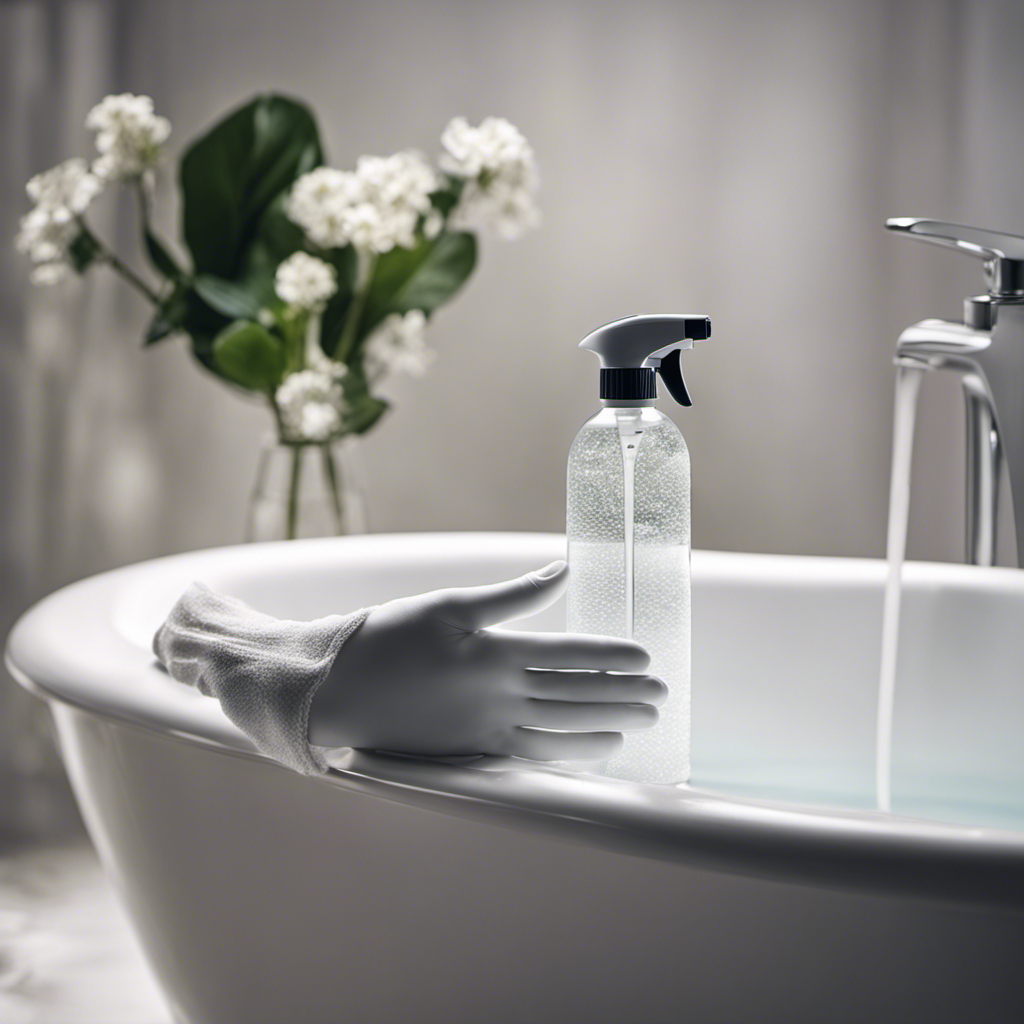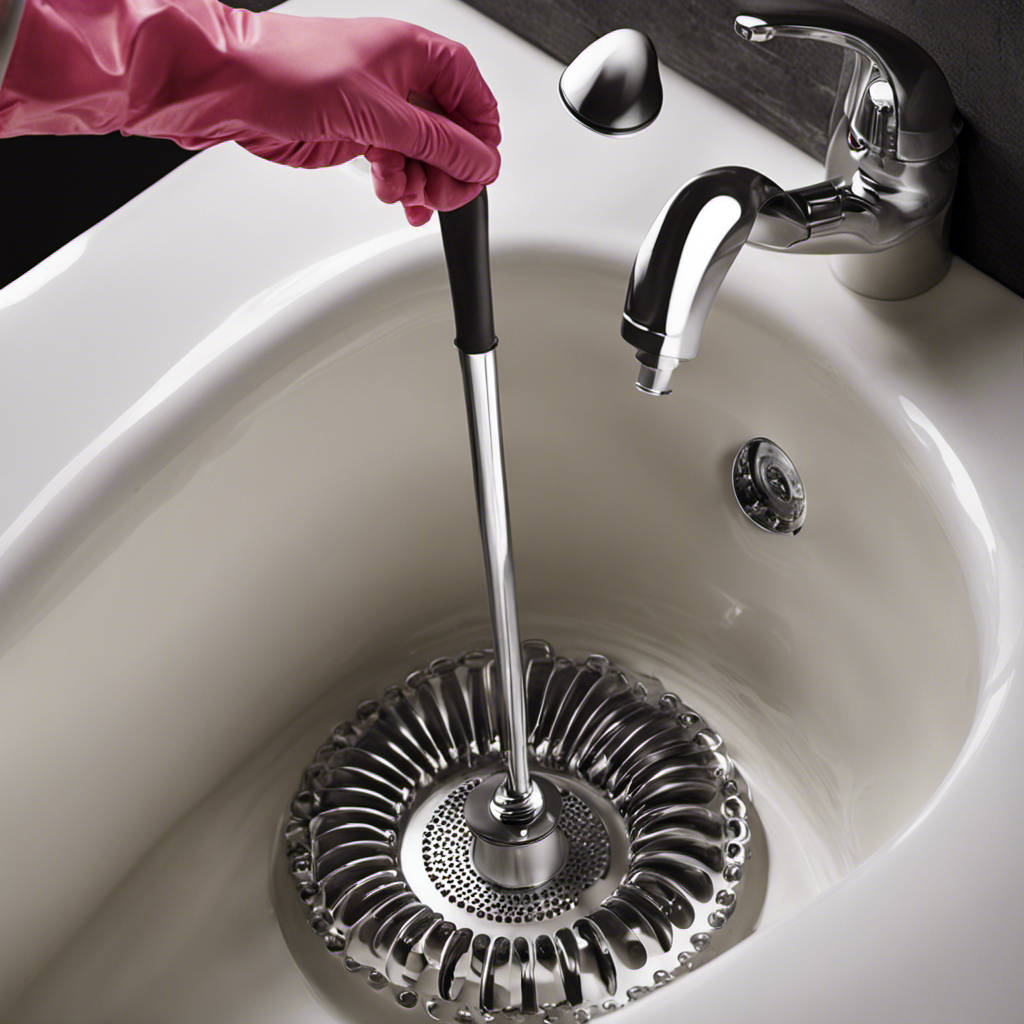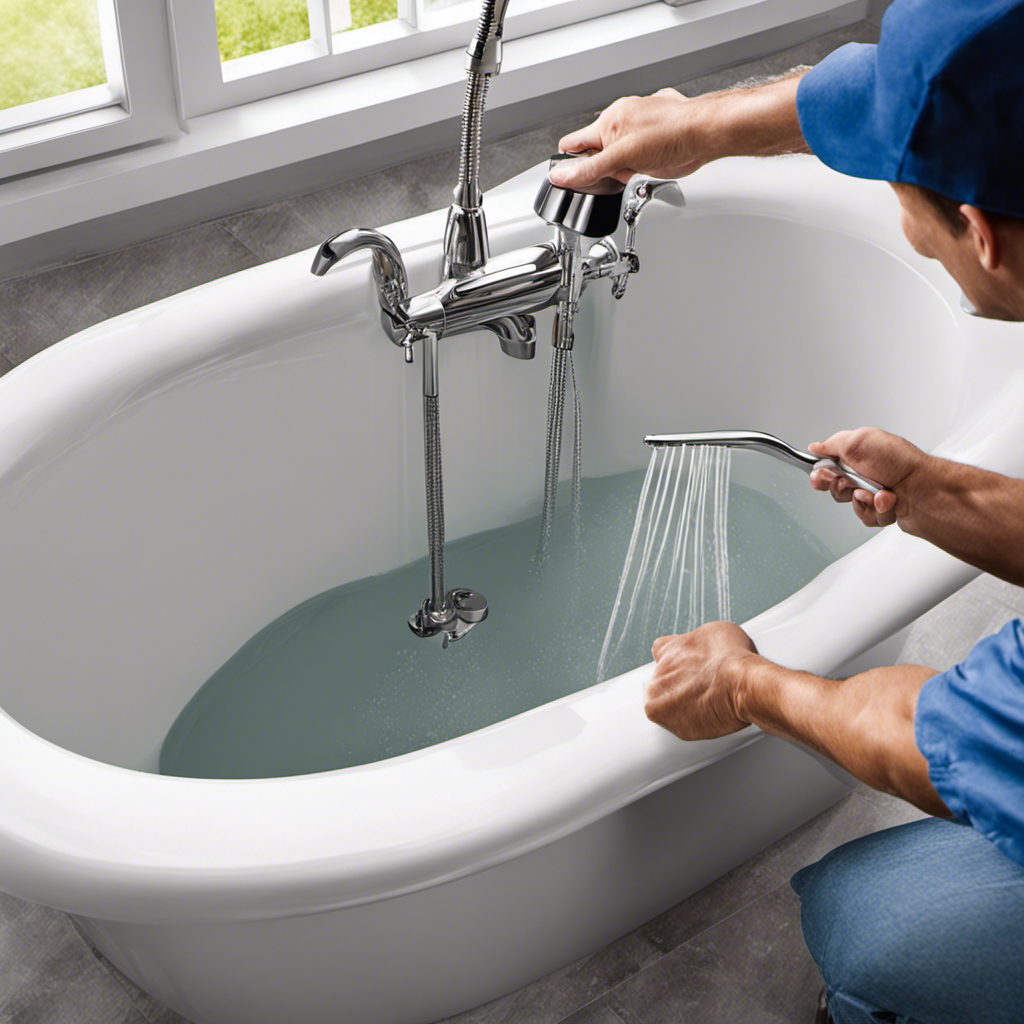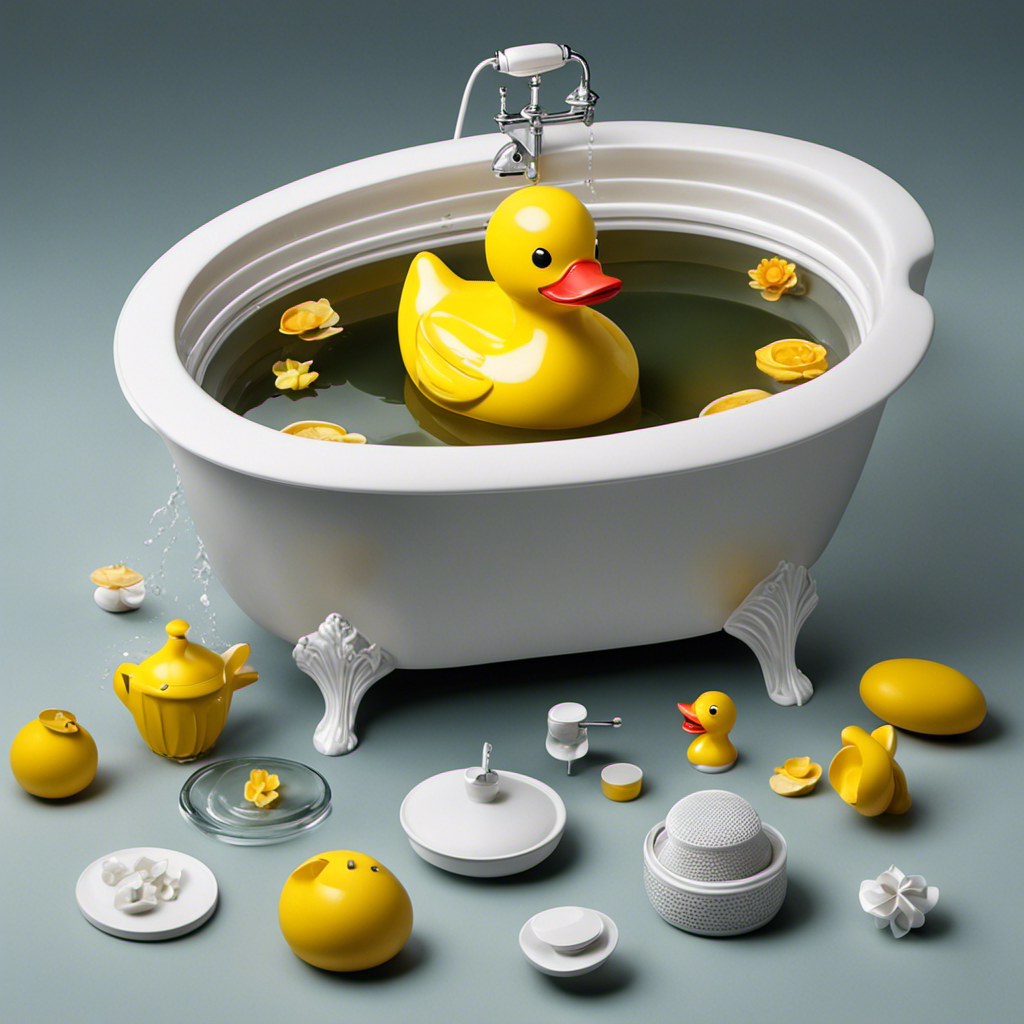I’ve always believed that a clean bathroom is a sanctuary. But when it comes to the bathtub, it can be a breeding ground for bacteria and germs.
That’s why I’m here to guide you through the process of disinfecting your bathtub, ensuring a spotless and hygienic space.
With a few simple steps and the right supplies, you’ll be able to restore your bathtub to its pristine condition.
So let’s roll up our sleeves and get started!
Key Takeaways
- Use a good quality bathtub cleaner or disinfectant spray for effective disinfection.
- Regularly remove debris from the bathtub using natural alternatives like baking soda and vinegar.
- Clean the surface of the bathtub before disinfecting to ensure effective disinfection.
- Follow safety precautions when preparing and using a disinfecting solution, such as wearing gloves and ensuring proper ventilation.
Step 1: Gather the Necessary Supplies
First, you’ll need to gather the necessary supplies for disinfecting your bathtub. Ensuring proper cleaning of your bathtub is of utmost importance.
Regular maintenance not only keeps your bathtub looking clean and fresh but also helps in preventing the growth of bacteria and germs.
To achieve this, you’ll need a few key items. Start by getting a good quality bathtub cleaner or disinfectant spray. Look for products that are specifically designed to remove stains, soap scum, and kill bacteria.
Additionally, you’ll need a scrub brush or sponge to scrub away any dirt or grime. Don’t forget to grab a pair of rubber gloves to protect your hands.
Lastly, have some clean, dry towels nearby to wipe down the bathtub after disinfecting.
Step 2: Remove Any Loose Debris
Before diving into the process of disinfecting a bathtub, it is crucial to clear the bathtub of any loose debris. This step is of utmost importance as debris can hinder the effectiveness of the disinfection process and potentially contaminate the surface.
Clear Bathtub of Debris
To clear your bathtub of debris, you’ll want to start by removing any loose hair or particles. Regular maintenance is important to keep your bathtub clean and prevent clogs. By regularly clearing debris, you can avoid build-up and maintain a hygienic bathing space. Not only does this ensure a pleasant bathing experience, but it also prolongs the lifespan of your bathtub. To make your cleaning routine more eco-friendly, you can opt for natural alternatives. For instance, instead of using chemical-laden cleaners, you can try a mixture of baking soda and vinegar to effectively remove stains and grime. This not only reduces the use of harmful chemicals but is also a cost-effective solution. By incorporating these eco-friendly cleaning alternatives into your regular maintenance routine, you can contribute to a healthier environment.
| Advantages of Regular Maintenance | Eco-Friendly Cleaning Alternatives | Importance of Regular Maintenance | Eco-Friendly Cleaning Alternatives |
|---|---|---|---|
| Keeps bathtub clean and hygienic | Baking soda and vinegar mixture | Prevents clogs and build-up | Reduces use of harmful chemicals |
| Prolongs the lifespan of the bathtub | Cost-effective solution | Enhances bathing experience | Contributes to a healthier environment |
Importance of Debris Removal
Regularly clearing debris from your bathtub is essential for maintaining cleanliness and preventing clogs. Debris, such as hair, soap scum, and dirt, can accumulate over time and create a breeding ground for bacteria.
To effectively remove debris, there are several techniques you can employ. First, use a drain strainer to catch larger particles and prevent them from entering the drain. This simple tool can significantly reduce clogs and make debris removal easier.
Additionally, regularly scrubbing the bathtub surface with a mild cleaning solution can help remove any residue or buildup. Paying attention to hard-to-reach areas, such as corners and grout lines, is crucial.
Properly disposing of the collected debris is also important to prevent it from reentering the bathtub.
Cleaning Before Disinfecting
Cleaning the surface of your tub is an important step in maintaining a hygienic bathing environment. To effectively clean your bathtub, there are a few techniques you can use.
Firstly, start by removing any visible dirt or grime using a soft brush or sponge. Make sure to scrub all areas of the tub, including the corners and edges.
Next, choose the best disinfectant for your tub. Look for products that are specifically designed for bathroom surfaces and are effective against a wide range of bacteria and viruses. Some popular options include bleach-based cleaners or hydrogen peroxide solutions. These disinfectants will help eliminate any harmful germs that may be present on the surface.
Once your tub is clean, it’s time to move on to the next step: preparing a disinfecting solution.
Step 3: Prepare a Disinfecting Solution
When it comes to disinfecting, it’s important to choose the right cleaning products to effectively eliminate germs and bacteria.
Some commonly recommended cleaning products include bleach, hydrogen peroxide, and alcohol-based disinfectants.
In addition to selecting the right products, it is crucial to follow effective disinfection methods such as allowing the solution to sit for the recommended amount of time and using proper techniques for wiping down surfaces.
Lastly, it is essential to prioritize safety precautions such as wearing gloves, ensuring proper ventilation, and avoiding mixing different cleaning chemicals to prevent any harmful reactions.
Cleaning Products to Use
To effectively disinfect your bathtub, you should use bleach or hydrogen peroxide. These cleaning agents are highly effective at killing germs and bacteria that may be lurking in your tub.
However, it’s important to use caution when handling bleach, as it can be harmful if not used properly.
If you’re looking for more eco-friendly options, there are natural cleaning techniques that can be just as effective. Some environmentally-friendly options include using vinegar and baking soda, which are both powerful cleaners and safe for the environment.
Another option is using tea tree oil, which has natural antibacterial properties. These eco-friendly alternatives not only provide a thorough clean, but also help reduce your carbon footprint.
Effective Disinfection Methods
Bleach and hydrogen peroxide are highly effective at killing germs and bacteria in your tub, but it’s important to handle them with caution. When it comes to disinfecting your bathtub, there are several effective methods and best practices to consider. One method is using a bleach solution, which can be made by mixing one part bleach with ten parts water. This solution should be applied to the tub surface and left to sit for at least five minutes before rinsing thoroughly. Another option is using hydrogen peroxide, which can be applied directly to the tub surface and left for several minutes before rinsing. Both of these methods are effective in killing germs and bacteria, but it’s important to follow the instructions and precautions on the product labels.
To further illustrate these methods, here is a table that compares the effectiveness and usage of bleach and hydrogen peroxide:
| Method | Effectiveness | Usage |
|---|---|---|
| Bleach | Highly effective | Dilute with water before applying |
| Hydrogen Peroxide | Highly effective | Apply directly to the tub surface |
Safety Precautions to Take
For your safety, it’s important to handle bleach and hydrogen peroxide with caution when using them as disinfectants. These powerful cleaning agents can be harmful if not used properly.
Here are some safety precautions to keep in mind:
- Wear protective gloves and goggles to prevent direct contact with the chemicals.
- Always read and follow the instructions on the product labels to ensure proper dilution and application.
- Avoid mixing bleach or hydrogen peroxide with other cleaning products, as this can create toxic fumes.
- Use the disinfectants in a well-ventilated area to minimize inhalation of fumes.
- Store the chemicals in a safe place, away from children and pets.
By taking these precautions, you can protect yourself and others from harm while effectively disinfecting your bathtub.
Now, let’s move on to the next step: applying the disinfecting solution to the bathtub.
Step 4: Apply the Disinfecting Solution to the Bathtub
Spread the disinfecting solution evenly across the surface of your bathtub.
When it comes to bathtub disinfectant options, there are a few alternatives to consider. One popular option is using a mixture of bleach and water. To create this solution, combine 1/2 cup of bleach with 1 gallon of water.
Another alternative disinfection method is using hydrogen peroxide. Fill a spray bottle with hydrogen peroxide and spray it onto the surface of your bathtub. Let it sit for a few minutes before wiping it away.
Vinegar is another effective option. Mix equal parts of white vinegar and water, then apply it to your bathtub.
These alternative disinfection methods are great for killing bacteria and germs, ensuring a clean and sanitized bathtub.
Step 5: Scrub the Bathtub Thoroughly
Now that you’ve applied the disinfecting solution, it’s time to scrub the bathtub thoroughly to remove any dirt and grime. Using the right scrubbing techniques and recommended cleaning products is essential for achieving a sparkling clean bathtub. Here are some tips to help you get the job done effectively:
- Start by using a soft-bristle brush or sponge to gently scrub the surface of the bathtub.
- Pay extra attention to areas that are prone to soap scum and stains, such as the corners and around the drain.
- For tough stains, you can use a paste made of baking soda and water. Apply it to the stain, let it sit for a few minutes, and then scrub it away.
- To prevent scratches, avoid using abrasive cleaners or scrub brushes with stiff bristles.
By following these scrubbing techniques and using the recommended cleaning products, you can ensure that your bathtub is thoroughly cleaned and free from dirt and grime.
Now, let’s move on to the next step: rinsing the bathtub with clean water.
Step 6: Rinse the Bathtub With Clean Water
After you’ve scrubbed the bathtub thoroughly, it’s time to rinse it with clean water to remove any remaining cleaning products and residue. This step is crucial in maintaining your bathtub and preventing mold growth.
To start, I recommend using a detachable showerhead or a bucket filled with clean water. Begin by wetting the entire surface of the bathtub, making sure to reach all corners and crevices.
Then, using a clean sponge or cloth, wipe down the bathtub, paying special attention to areas where cleaning products may have accumulated. Rinse the sponge or cloth frequently to prevent spreading any residue.
Once you’ve thoroughly rinsed the entire bathtub, use a towel to dry the surface completely. This final step will help prevent moisture buildup and inhibit mold growth.
Step 7: Dry and Maintain the Bathtub for Future Use
To keep your bathtub in good condition for future use, make sure to dry it thoroughly after each use and regularly clean any residue or buildup. Proper bathtub maintenance is essential not only for aesthetic purposes but also for preventing future contamination. Here are some important steps to maintain your bathtub:
-
Dry the bathtub after each use:
-
Use a clean towel or squeegee to remove any excess water.
-
Pay special attention to areas where water tends to collect, such as corners and edges.
-
Regularly clean the bathtub:
-
Use a mild cleaner or a mixture of vinegar and water to remove soap scum and stains.
-
Scrub the surface with a soft brush or sponge, focusing on areas prone to buildup.
Conclusion
In conclusion, disinfecting a bathtub is a crucial step in maintaining a clean and hygienic bathroom environment. By following the steps outlined above, you can ensure that your bathtub is free from harmful bacteria and germs.
Did you know that a study conducted by the National Sanitation Foundation found that the average bathtub contains more bacteria than a trash can? This statistic highlights the importance of regularly disinfecting your bathtub to prevent the spread of illness and maintain a healthy living space.
So, don’t forget to include bathtub disinfection in your cleaning routine!










